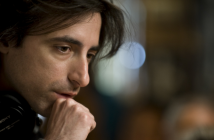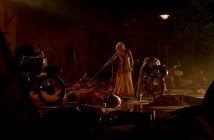
Editor’s Notes: The following review is part of our coverage of the 2014 Toronto International Film Festival. For more information on the festival visit http://tiff.net and follow TIFF on Twitter at @TIFF_NET.
Among the chaos of seeing films and reviewing at TIFF, I got the chance at interviewing emerging director Martti Helde. In The Crosswind is set in Estonia where thousands were deported to Siberia by the Soviets in the forties in a Stalin ordered ethnic cleansing. Told through Erna, a young woman who was separated by her family during the tragedy, it is a powerful film.
I sat down with the young director to talk about his directing process and the choices he made to tell his people’s story.
Jacqueline: This story is very important to you. What inspired you to pick Erna’s story in particular?
Martti Helde: The impact was that she seemed sharp. She was a really good observer, even though she was in the middle of nowhere in Siberia. There were insightful remarks she made about life in Siberia and how she dealt with it, were amazing. It was different than all the other stories I’ve read. That amazed me. How someone who is struggling for life can still write really sharp notes about life, about time, and how time has stopped. That was a really nice impact. She was something special.
Jacqueline: She was a philosophy student, I believe, right?
Martti Helde: Yes. She quit university, of course, when she was deported. But during that time in the forties there was really a small amount of female students. In Estonian cultural ways, if you were a lady you had to be at home, take care of the kids and everything, but she had kids and was studying at the university. It was totally uncommon then.
Jacqueline: What made you decide on an entire tableau vivant style for this film?
Martti Helde: I was inspired by the one sentence that Erna says, “I feel like time has stopped. My mind is travelling in Siberia, but my mind is at home.” Then it striked me that I had to find the visual language to express the same thing through the camera. Tableaux vivant seemed like the right choice because I wanted the audience to feel the same thing, in a sense. That they can’t do anything, you just have to watch those things I decide to put up on the screen, kind of like a visual prison.
When you are watching live action film, you can decide where your focus point is, like I’m going to watch this character or this one. But when I’m the one moving the camera around these haunting images, then the audience doesn’t have a choice, but look where the camera turns. It was hard to make it that way though.
Jacqueline: Yeah! How did you do that? Where you calling out directions while you were moving the camera or did you have it planned out?
Martti Helde: Yup. We planned. It depended on how difficult the scene was. The typical preparation time for one scene was two months. The maximum was six months. We basically took two to six months to prepare where the characters were standing, what are they doing, their positions, what they’re wearing, if they were using tools or suitcases, or whatever. So we basically made the film floor plans and marked the characters with a number and letters. Then we did the casting to find the type of faces we were looking for. We had to plan all that ahead of time so that we didn’t have any room for mistakes. We’d have all those months and then just one day to shoot the scene; from first thing in the morning to last part of the night.
Jacqueline: You also had children on set so that must have been the experience as well.
Martti Helde: That was hard. The biggest thing was 150 or so actors and in the morning there were more kids and in the evening there were tired. Most of the kids by that time are sleeping because the shooting days were so long. The longest day was sixteen hours. We’d start with rehearsals, then figuring out their emotions for the scene, and learn the stylistics throughout the day.
Jacqueline: I’ve learned a lot stories about histories revealed. How is it received in Estonia?
Martti Helde: The Estonian premiere was in March and the feedback we’ve received has been really positive. It seemed to fill a gap that was missing. It’s the first film about the Estonian deportation. The Soviet troops were in Estonia for fifty years and it was taboo to talk about it and write about it. The fifty year gap was really hard for those people who were the victims who came back. In The Crosswind was kind of a relief for those who are still alive. I’ve received so many thank you letters because they were waiting for someone to make a film or tell the story about it. The world didn’t know it because of the Soviet occupation.
That was the main message for our crew as well because we want to share the message and our history. And why Estonians are like we are.
Jacqueline: What do you mean, is there an Estonian personality trait?
Martti Helde: Well, kind of. It’s not super outgoing. It’s really quiet and you take everything how it is. We’re rather introverted than extroverted. That’s because my grandparents and even my parents weren’t allowed to show their feelings because in the sense of the Communist system they were under, if you’re different, it’s not allowed and you’re sent away.
Grand parents and youngsters came out to the cinema to see the film. I went to the last screening in May to see who were the people going to see it. It was really moving to see young and old together in the theatre.
The cinemas called on us after the first week to tell us that it was the first time people were leaving at the end credits. They were staying! They sat until the end credits were over which is a nice compliment.
The song at the end credits is a national thing, a really old song. It’s a lullaby. It’s nice to know people were carried away from the cinema with that song.
And of course, there are people who don’t like it all. That’s ok with me. That’s totally fair. I mean, I don’t like all the movies in the world.
Jacqueline: Was there a scene that was particularly difficult for you to film, emotionally?
Martti Helde: There were two scenes actually. There is a scene in the middle of the film where the daughter dies. It was really emotional and hard. And the other scene is when Heldur is shot in the prison camp. They were my characters and I had to kill them off. All the stories that I had read of them were super emotional and it was also very hard for the actors.
Funny thing with the kid in that scene, when she dies, we had five people on the set, we cleared all the studio because it had to be filmed in total silence. We whispered into the walkie-talkies because the child fell asleep. In the film, she is sleeping and we didn’t want to wake her up. Later on we understood that the silence made the scene.
Jacqueline: This is a very moving story with colorful and emotions words by Erna, why shoot it in black and white?
Martti Helde: Memories from the forties felt like they had to be in black and white, you know?
Jacqueline: It’s true. Whenever I think of time back then, I tend to think of everything in black and white because of the movies.
Martti Helde: And photographs. There was no question to make it in black and white. All the reference materials and the photographs were in black and white. We wanted to focus on the form, the overall image, and the shadows. We used the greyness, whiteness, and darkness to express it all.
Jacqueline: Any time a train was present and moving in the film, I noticed whispers taking over the noise of the engine. Since I don’t speak Estonian, what are they saying? And what made you choose the score?
Martti Helde: That’s a really good question. You’re one of the first people to ask me that. Just two have asked me, the previous one was an Estonian reporter and now you. That’s really cool.
It’s their names. There’s a thick book in Estonia with the names of those that were deported and I took real names from it, lined them all up alphabetically. I had thirty professional actors to come the studio and a conductor play around with the names to create the feeling of wind. The idea came from my sound designer. When he saw the film, he said he wanted to make it sound like wind with voices and I said, “Let’s make it with names.” The names can be weird to comprehend because they’re Estonian and in the forties the names were a bit different. I really loved this process of the whispering choir.
I’ve known the score composer for fifteen or twenty years. We’ve been friends since childhood. I was doing school theatre and he was as well, and then later on he got into music. I asked him four years ago when I started making the movie if he would do the music. He’s scored some of my short films. He’s also a super sensitive person and I think he’s a genius, although he doesn’t know it. He’s twenty-six, as young as I am. But how he sees the world is amazing.



